
Bioethics expert urges health sciences graduates to use their voices to combat disinformation
Quinnipiac conferred degrees to 774 graduates of the School of Health Sciences
May 13, 2023

May 13, 2023
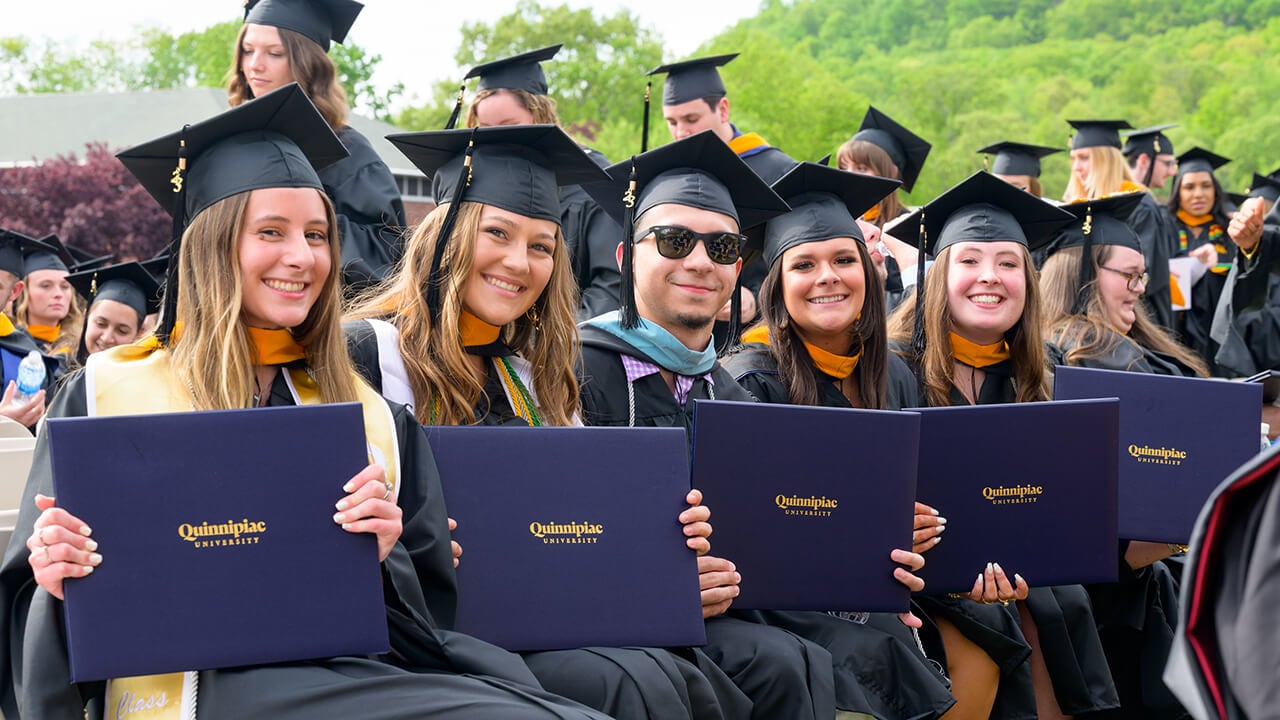
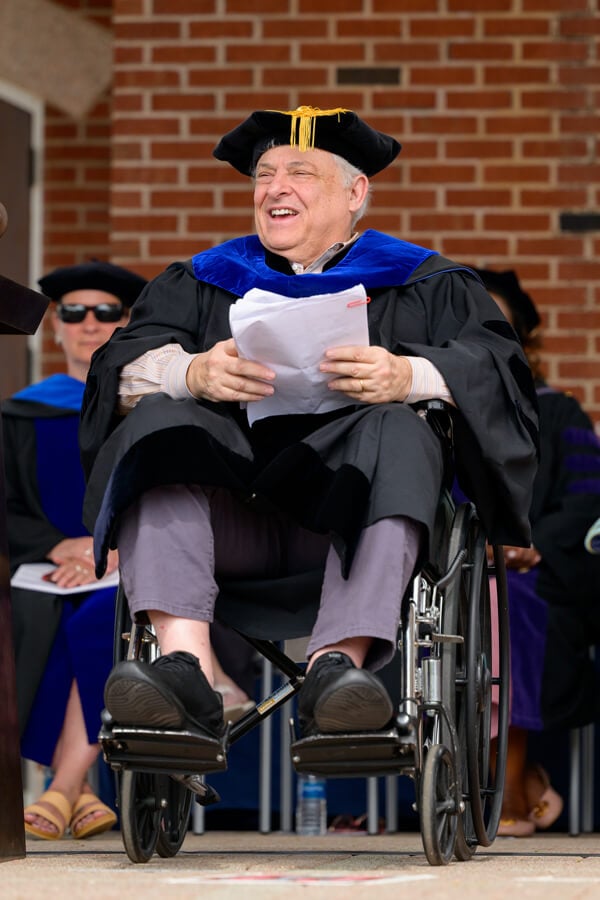
One of the most influential and outspoken voices in his field, Caplan detailed his own battle with polio, with which he was afflicted at the age of 7. After witnessing children his age confined to iron lungs and their families kept in the dark about the harsh realities of their condition, he said he made it his life’s work to amplify medical information and protect it from those who would corrupt it for personal gain.
The threat has only been compounded in the age of social media, where it’s all too easy to pose as an expert and denounce genuine medical advancements in favor of unproven alternatives.
“You have the power to inform, to sway minds,” Caplan told the graduates. “You all today are the best antidote to ignorance and disinformation that I can think of. You can do it. Power has decided that it doesn’t always want to hear what science and medicine believe. You can play a big role in combatting that inclination.”
Caplan said he enjoyed being in the “home of champions,” a nod to the university’s recent men’s ice hockey national championship triumph. He was just as honored to be in the company of future champions of the healthcare community, he said.
President Judy Olian praised the Class of 2023 for “adapting gracefully” to the COVID-19 pandemic and the resulting pivot to remote learning in the spring of 2020. With so many graduates headed for impactful professions within the healthcare community, she urged them to be a “caretaker of the whole person — a daunting yet uplifting responsibility.”
“You’ll carry with you the life experiences of the last few years that have made you stronger and more resilient, that have exposed you to some new ways of thinking, to different ideas, to different people and cultures,” she said. “You’ve also seen the stark realities of healthcare inequities that you must try to ameliorate with your personal powers and caring.”
Olian reminded the graduates that wherever their careers and their lives take them, they will always have a second home in Hamden and North Haven. And they will immediately reap the benefits of their newfound membership to the robust network of professional Bobcats.
“Please remember that this is your home away from home,” said Olian, who was introduced by associate provost for faculty affairs Khalilah Brown-Dean. “You are a Bobcat for life. Visit us often, and stay connected to the friends, faculty and staff who have supported you and accompanied you on this journey over the last few years. Today, you join a global alumni community that is more than 60,000 strong, and I encourage you to take full advantage of that powerful network.”
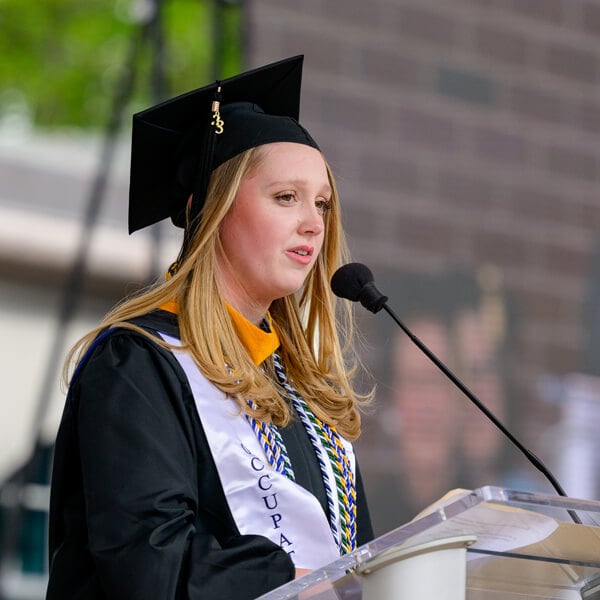
After Paige Pezzella ’24, a third-year media studies and English major, sang the national anthem, Bobbi Ames Dynice, MSOT ’23, welcomed the crowd on behalf of the Class of 2023.
Dynice thanked the faculty from the School of Health Sciences and acknowledged family and friends who had gathered in support of the graduates before turning her attention to her classmates.
“Graduation is our dawning and I hope we all have many bright days ahead,” Dynice said. “Today is not an ending, but truly our new beginning.”
In the student response address, Vincent Pedulla BS ’23 recalled an encounter he had with a dining services employee after he and another classmate had just finished the grueling process of taking the Medical College Admissions Test. The woman said she once dreamed of becoming a healthcare professional and offered to pray for their success.
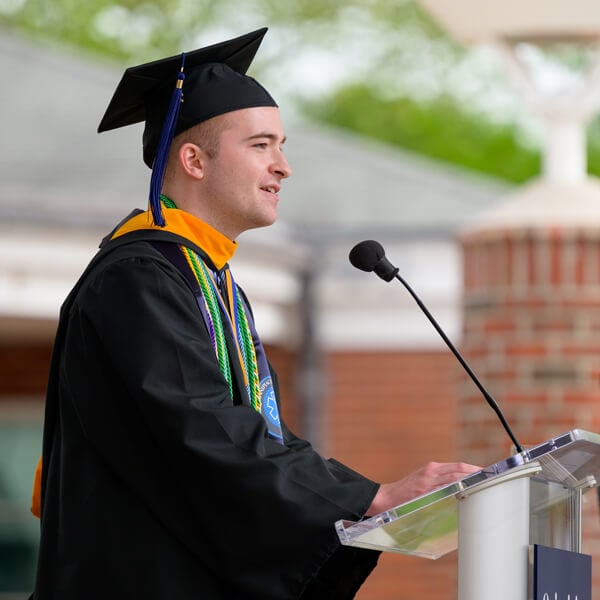
Weeks later, Pedulla reconnected with the woman and was greeted just as warmly. It’s a reminder, he said, that interpersonal connections are what makes the job so rewarding.
“Don’t lose sight of moments like those,” said Pedulla, who lived in the first-year Honors Living-Learning Community (LLC) before serving as a resident assistant. “They’re the moments that make our life of work so special.”
Dean Janelle Chiasera presented the candidates and prepared them for the conferral of their degrees, an honor performed by Olian. Alumni Association Board Chair Jeanna Doherty ’94 concluded the ceremony with an official welcome for the Class of 2023 on behalf of the Bobcat alumni community.
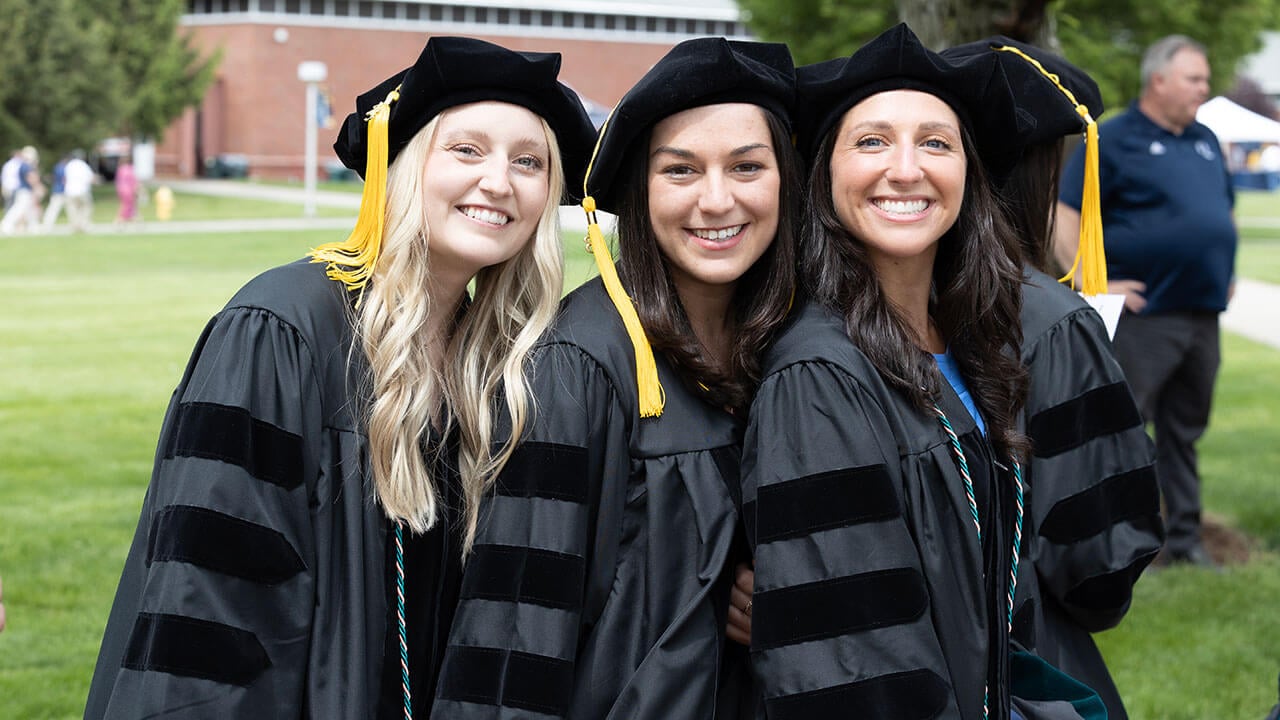
Pomp and Circumstance, Sir Edward Elgar
Khalilah Brown-Dean, PhD
Associate Provost for Faculty Affairs
Paige Pezzella ’24
Judy D. Olian, PhD
President
Bobbi Ames Dynice, MSOT ’23
Vincent Gabriel Pedulla, BS ’23
Clotilde Dudley-Smith
Director of Health Science Program, Director of Health Science Online Degree Completion Program
Arthur Caplan, PhD
Drs. William F. and Virginia Connolly Mitty Professor of Bioethics, New York University
Janelle Chiasera, PhD
Dean
Judy D. Olian
Jeanna Doherty ’94
Chair, Alumni Association Board
Amor Vittorioso | G. Gastoldi
March | A. Valenti

School of Health Sciences Undergraduate and Graduate Ceremony | Saturday, May 13, 3 p.m.
Arthur L. Caplan, PhD, is one of the most influential voices in the field of bioethics. Since 2012, he has served as a professor of bioethics at the NYU Grossman School of Medicine, the latest stop in a long and distinguished academic career. A fixture on the cable news circuit and a frequent contributor to major print media outlets, Dr. Caplan is never shy about voicing an opinion when it comes to medical trends — usually with a healthy dose of wit. He has written or edited 35 books and has published over 800 papers in peer-reviewed journals. He received his bachelor’s degree in philosophy from Brandeis University in Waltham, Massachusetts, and went on to earn a Master of Arts, a Master of Philosophy and a PhD from Columbia University. Born in Boston, he now resides in New York City with his wife, Meg.

Congratulations to the Class of 2023! You are well prepared to continue your life journey as professionals who will impact the world and the workplaces of tomorrow. We are confident you will apply your talent, passion and education to serve boldly as engaged citizens in your communities — and beyond. These qualities are at your core and will continue to propel you well into the future.
As graduates of Quinnipiac University, you have learned from a distinguished faculty and a committed staff who proudly stand beside you today. You also have learned valuable lessons from each other during this most transformative time in your lives. Please stay connected to our Bobcat family, visit us often, and draw upon the many friendships and mentorships you have formed here.
This day is shared with your families and friends, those who also deserve special recognition and appreciation for their contributions to your success. Enjoy this momentous achievement! Together, we are cheering for you, with utmost pride.
Warmly
Judy D. Olian
The mace — a symbol of authority — has antecedents in both Roman and Medieval history. The Roman mace (fasces) was carried by a lictor before the chief magistrate of the city, as well as before the legions. During the Middle Ages, the mace (mateola), a weapon of war, became first a symbol of victory and then a symbol of authority. The mace emblazoned with the Great Seal of England became a symbol of authority in Parliament by the end of the 13th century. It is this form of the mace that was the prototype of those symbols of authority, not only of legislative bodies, but also of cities and universities.
In 1246, following some 20 years of strife, the University of Paris was finally conceded the right to its own common seal. Since then, the use of the seal engraved on the mace has come to symbolize the authority of the academic community. In July 2000, Quinnipiac commissioned the noted sculptor Robert Meyer of Westport, Connecticut, to design and execute a new mace for Quinnipiac University. Cast in bronze, the mace incorporates elements of the university seal.
The medallion (medal of office), like the mace and the seal, is also a symbol of authority. It is possible that its roots may be traced back to the Roman “bulla” (a gold amulet of honor). The obverse of the medallion shows the seal of the office the wearer holds — in our case, the seal of the university. Not infrequently, the reverse would show the personal seal or coat of arms of the bearer. Since the High Middle Ages, the medallion has been worn by such officials as the chancellors of England, mayors of cities, and rectors of universities, and came to signify the high personal position such figures occupied in their respective governments. During the Renaissance, medallion design reached unique artistic heights, and in certain portraits the medallion was given particular prominence. The medallion is worn by the university’s president. The Quinnipiac medal showcases the university seal, sculpted in relief and cast in bronze.
The 12th and 13th centuries saw the formation of universities under the jurisdiction of the Church. Most students of the day were clerks in the Holy Order, monks or priests. Cowls or hoods adorned their habits and protected the young scholars from harsh weather and the pervading dampness of the stone buildings in which they studied. Hoods also served to cover tonsured heads before the use of the skullcap.
Today, the cap, gown and hood have taken on a symbolic meaning. Color and shape conform to an academic code signifying a university’s conferral of the degree and the nature of the degree conferred. Gowns for the doctoral degree carry velvet panels and three horizontal velvet bars on the upper arm of the full, round, bell-shaped sleeves.
Quinnipiac University conferred 3,141 degrees during six Commencement ceremonies May 12-14 at the M&T Bank Arena and the Mount Carmel Campus.
Quinnipiac Today is your source for what's happening throughout #BobcatNation. Sign up for our weekly email newsletter to be among the first to know about news, events and members of our Bobcat family who are making a positive difference in our world.
Sign Up Now